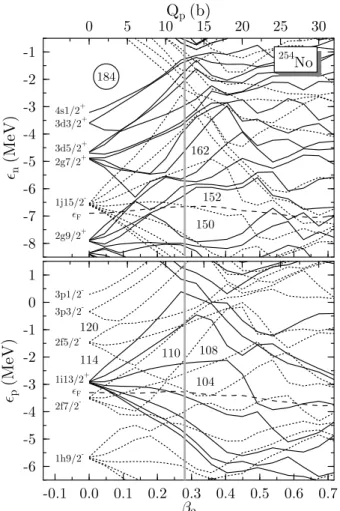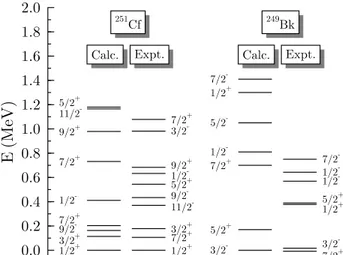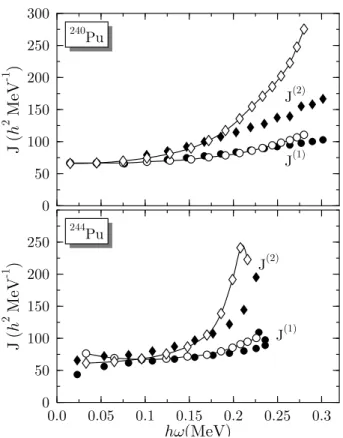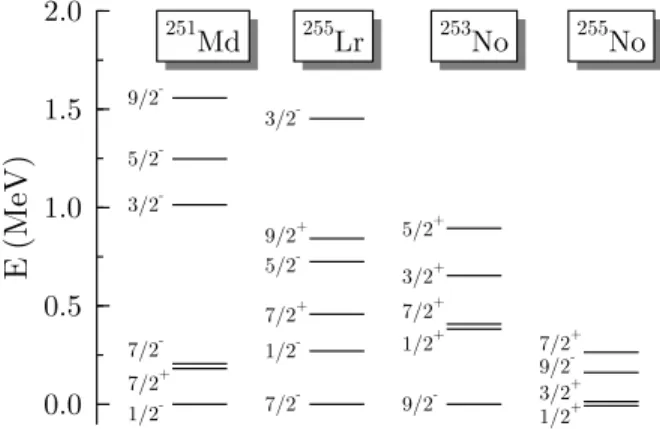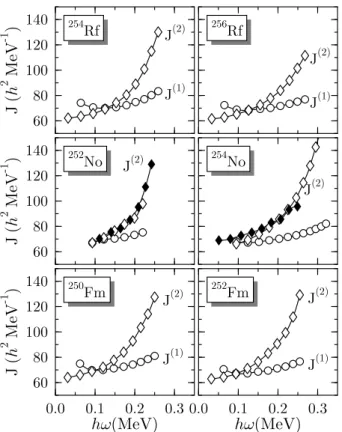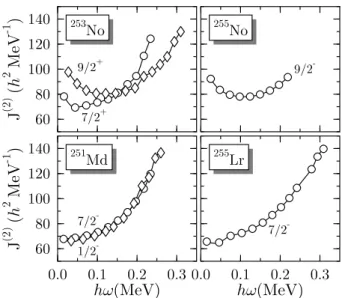HAL Id: cea-02928082
https://hal-cea.archives-ouvertes.fr/cea-02928082
Submitted on 2 Sep 2020HAL is a multi-disciplinary open access
archive for the deposit and dissemination of sci-entific research documents, whether they are pub-lished or not. The documents may come from teaching and research institutions in France or abroad, or from public or private research centers.
L’archive ouverte pluridisciplinaire HAL, est destinée au dépôt et à la diffusion de documents scientifiques de niveau recherche, publiés ou non, émanant des établissements d’enseignement et de recherche français ou étrangers, des laboratoires publics ou privés.
Skyrme Mean-Field Study of Rotational Bands in
Transfermium Isotopes
M. Bender, P. Bonche, T. Duguet, P.-H. Heenen
To cite this version:
M. Bender, P. Bonche, T. Duguet, P.-H. Heenen. Skyrme Mean-Field Study of Rotational Bands in Transfermium Isotopes. Nuclear Physics A, Elsevier, 2003, 723 (3-4), pp.354-364. �10.1016/S0375-9474(03)01081-9�. �cea-02928082�
arXiv:nucl-th/0302058v1 20 Feb 2003
Skyrme Mean-Field Study of Rotational
Bands in Transfermium Isotopes
M. Bender
aP. Bonche
bT. Duguet
b,1P.-H. Heenen
aaService de Physique Nucl´eaire Th´eorique, Universit´e Libre de Bruxelles, C.P.
229, B-1050 Bruxelles, Belgium
bService de Physique Th´eorique, CEA Saclay, 91191 Gif sur Yvette Cedex, France
Abstract
Self-consistent mean field calculations with the SLy4 interaction and a density-dependent pairing force are presented for nuclei in the Nobelium mass region. Pre-dicted quasi-particle spectra are compared with experiment for the heaviest known odd N and odd Z nuclei. Spectra and rotational bands are presented for nuclei around252,4No for which experiments are either planned or already running.
Key words:
PACS:21.60.Jz, 27.90.+b, 21.10.Pc, 21.10.Re
1 Introduction
Effective interactions used in microscopic mean-field models are built from nu-clear ingredients such as ground-state properties of selected nuclei and infinite nuclear matter [1]. No information coming from rotational bands of deformed nuclei is a priori implemented in these forces. The variation of the moment of inertia along a band is related to the evolution of pairing correlations with rotation. Such a variation brings other constraints on the structure and the strength of the pairing interaction [2]. Furthermore, properties of bands in odd-mass nuclei are a fingerprint of the quasi-particle excitations on which they are built and, thus, of the single-particle spectra predicted by the effec-tive mean-field interaction. Experimental study of rotational spectra in nuclei
Email address: mbender@ulb.ac.be(M. Bender).
1 Current address: Physics Division, Argonne National Laboratory, Argonne, IL 60439
far from stability is thus an important tool to test the predictive power of these forces.
The recent experimental results for the Nobelium isotopes252No and254No [3,4,5,6,7] are in this respect of particular importance. They bring data in a region close to the domain of super-heavy nuclei, where our knowledge of single-particle spectra and of pairing correlations is particularly limited. Since then, further experiments have been proposed or are already underway for other even-even and odd-mass nuclei in this mass region; new results are expected to appear soon. This experimental context has triggered a number of theoretical stud-ies with various mean-field models. Fully self-consistent cranked HFB calcu-lations have been performed for selected nuclei with several interactions: the Gogny force [8], the Skyrme interactions SLy4 and a density-dependent pairing force [2] and SkM* together with a schematic pairing force [9]. The relativistic mean-field model [10] has also been applied to this domain. Finally, let us quote the large scale microscopic-macroscopic study of Muntian et al. [11]. In this paper, we present calculations for the rotational bands of some even-even nuclides in the A = 250 mass region and of odd-mass isotopes differing from252No or 254No by either one neutron or one proton. We also discuss the spectra of quasi-particle states expected for these nuclei.
First, we briefly recall our method and present its main ingredients. We then calculate the spectra and rotational bands of the heaviest isotopes for which there are extensive experimental data. Finally, we calculate spectra and rota-tional bands of nuclei around the No isotopes.
2 The method
We have performed cranked HFB calculations following the method described in ref. [12]. The SLy4 parameterization of the Skyrme interaction [13] is cho-sen in the mean-field (particle-hole) channel. In the pairing (particle-particle) channel, we use a zero-range density-dependent force with the strength (V = −1250 MeV fm3) and cutoff (5 MeV) as in our previous study of252,254No [2]. The Lipkin-Nogami prescription is utilized to prevent a collapse of pairing correlations at high angular momentum. Quasi-particle excitations are calcu-lated fully self-consistently [14,15]. The effect of core polarization and of the blocking of a pair of states are thus exactly taken into account.
This model has been successfully used to describe super-deformed rotational bands [16] and super-heavy nuclei [17]. In ref. [2], we have compared our results with data on rotational bands of 252No and 254No.
Fig. 1. Single-particle energies for neutrons (top) and protons (bottom) calculated for254No (Z = 102, N = 152). The Fermi levels are indicated by long-dashed lines and the ground state deformation by a vertical gray line.
3 Results
3.1 Single-particle levels
The single-particle levels of 254No are plotted in figure 1 as a function of the axial quadrupole moment. These energies are eigenvalues of the particle-hole part of the HFB Hamiltonian. They provide a useful link to simpler models. The proton level density around the Fermi surface is rather low at deformations around β2 = 0.28 which is the deformation that we obtain for 254No. In this region, there are numerous deformed shell closures in the proton spectrum: at Z = 98 and 100, below 254No and also at Z = 104, 108, 110. At the same deformation, there are regions of low neutron level density around N = 150 and 152 as well as N = 162.
Fig. 2. Low lying energy spectra of 25198Cf153 (odd N ) and24997Bk152 (odd Z). 3.2 Quasi-particle states in 251Cf and 249Bk
Before applying our method to nuclei for which experimental data are sparse, let us focus on the spectra of 251Cf and 249Bk which are the heaviest odd-neutron and odd-proton nuclei for which the low energy spectra are rather well known. Figure 2 gives the spectra of these odd nuclei calculated self-consistently from one quasi-particle excitations (1qp) built on an HFB vac-uum. All states which are calculated to lie below 1.2 MeV are compared with experiment. Data are from ref. [18] and references therein for both nuclei and also from ref. [19] for251Cf.
The states we have calculated in 251Cf are characterized by a deformation β2 around 0.26, with the exception of the 1/2− state at 410 keV, which is significantly more deformed (β2 = 0.273 using the relation between β2 and the quadrupole and hexadecapole moments given in ref. [17]). These values are significantly larger than the fixed β2 value used by ´Cwiok et al. [20] (0.247) in their calculations based on a Woods-Saxon potential and the Strutinsky prescription. However, a clear conclusion is difficult to draw: in ref. [20], β2 is a priori fixed to be the same for all levels, whereas in self-consistent mean-field calculations, deformation is optimized level per level. In addition, the 1qp energies given in [20] are eigenvalues of the HFB Hamiltonian using an average potential, while our 1qp energies are total binding energy differences between self-consistent one quasi-particle states.
The ground state of 251Cf is obtained from the 1qp excitation predominantly based on the first single-particle state above the Fermi level, which has a spin of 1/2+, in agreement with the data. The first three excited levels correspond to 1qp states based on the single-particle levels just above (3/2+and 7/2+) or just below (9/2−) the Fermi level. This result is also consistent with experiment, with the largest error on the 9/2−state, too low by almost 300 keV. At higher
excitation energies, the energy of the 11/2− state is largely overestimated by our calculation. Other states are predicted with an accuracy of the order of 300 keV. We also obtain a 7/2+ state at 700 keV. Experimentally, the 3/2− state at 981 keV and the 7/2+ state at 1078 keV have been interpreted as due to the coupling of the 7/2+ 1qp excitation with the 2− octupole vibration and the 0+ pair vibration respectively. These states are thus outside the scope of our calculation. No 3/2−single-particle state is obtained below 1.2 MeV in our calculation. A rather similar spectrum is obtained in ref. [20], with however a much better energy for the 11/2− state at 370 keV. The RMF results of ref. [10] are in similar agreement with the data than ours, with, however a less dense spectrum for the two interactions that were tested.
We obtain a spin 3/2− for the ground state of 249Bk. The largest discrepancy with experiment isthe much too high energy for the 7/2+ state which is ex-perimentally nearly degenerate with the ground state. Our calculation also significantly overestimates the energy of the first 1/2+ state. All states have a very similar deformation β2 around 0.255. This value is slightly larger than the fixed 0.243 value used in [20]. The spin obtained in [20] for the ground state is 3/2−, but the 7/2+state is excited by only 150 keV. The RMF calculation [10] is in slightly better agreement with the data than our results, mainly because of a better energy for the 7/2+ state.
It is tempting to interpret the discrepancies observed between the calculated and experimental spectra in terms of the ordering of the single-particle levels at sphericity. For the neutrons and the251Cf spectrum, the too low 1qp energy of the 9/2− state above the Fermi level and the too high energy of the 11/2− state below the Fermi level could be corrected by a lowering of the energy of the 1j15/2− sub-shell. This would increase the N = 164 spherical energy gap, and also slightly reduce the deformed gap at N = 150 in favor of an increased N = 152 gap for typical ground state deformations around β = 0.28. The fact that the self-consistent models underestimate the N = 152 shell effect is also suggested by the experimental two-neutron separation energies [21] and Qα values [22,23].
The positions of the 5/2+ and 7/2+ states in 249Bk would be in better agree-ment with the data if the 1i13/2+shell were lower and if the splitting between the 3/2− and the 1/2− orbitals (labeled as [521]3/2− and [521]1/2− Nilsson states) was reduced by closer spherical 2f 7/2−and 2f /5/2− shells. A lowering of the energies of the 1j15/2− neutron and 1i13/2+ proton sub-shells can be achieved by an increase of the spin-orbit strength. However, this is not con-sistent with analyses showing that most Skyrme interactions overestimate the spin-orbit splitting in heavy nuclei [24]. In any case, to improve the description of the spectra by modifying the effective force requires deeper modifications than just the spin-orbit strength. One must also note that slight shifts of the levels could result from deformation modes not included in our model, like the
octupole mode.
Such modifications of the spherical sub-shells would affect the shell gaps for super-heavy nuclei. It would lead to a reduction of the deformed Z = 110 gap and an increase of the Z = 108 gap, in better agreement with the sparse available data. At the same time, the modified 1i13/2+and 2f 7/2−sub-shells would affect the Z = 114 gap in opposite ways and might not change it quan-titatively. Note that most parameterizations of the RMF model predict the proton 1i13/2+sub-shell to be below the 2f 7/2−state [24,10]. However, spec-ulations about the magicity of Z = 114 and Z = 120 based solely on the de-formed one quasi-particle states in 249Bk is questionable as increasing the charge number polarizes the nuclear density distribution, which feeds back into the single-particle spectra. For example, the spin-orbit splitting of 2f and 3p levels nearly vanishes for nuclides with semi-bubble shapes [25] that are predicted to appear around 292120 [24].
One must also keep in mind that large changes in the single-particle spectra will also affect other regions of the mass table. In particular, the lower members of the intruder proton 1i13/2+ and neutron 1j15/2− orbitals are responsible of several super-deformed rotational bands in the A = 190 mass region and cannot be changed by more than one or two hundred keV [14].
Recently, conversion electron cascades have been measured by Butler et al. [7]. The presence of high K-isomers was conjectured to explain the observed in-tensities. We have calculated the 2qp-excitations in 254No which can lead to high K-states. Most of them have excitation energies significantly larger than 2.0 MeV. The 2qp 7− state based on 7/2+ and 7/2− particle states (see fig-ure 1) is the only excitation that our calculation gives below 2.0 MeV, around 1.5 MeV. We have also determined its magnetic moment following the method developed by Hamamoto [26]. This configuration has a very large magnetic moment, around 1.5 W.U., as do several of the more excited configurations. Whether such a result is consistent with the present analysis of the experi-mental data requires further investigation.
3.3 Pu isotopes
Here, we discuss results of our method for the rotational bands of 240Pu and 244Pu for which recent detailed experimental data [27,28,29] have become avail-able. The kinematic (J(1)) and dynamic (J(2)) moments of inertia are compared with experiment in figure 3.
In both cases, the J(1) moment is in close agreement with the data at all ro-tational frequencies, while J(2) is overestimated at high rotational frequencies in a more pronounced way for240Pu than for 244Pu. In244Pu, the calculation
Fig. 3. Kinematical (circles) and dynamical (diamonds) moment of inertia for240Pu (top) and244Pu (bottom). Open (filled) markers denote calculated (experimental) values.
slightly underestimates the rotational frequency at which the alignment of a proton i13/2+ occurs. The same alignment does not occur in 240Pu up to J = 34 ~, both experimentally and theoretically. It has been suggested that this absence is due to octupole correlations [28] which however are not in-cluded in our calculation. Further investigations are necessary to clarify this point.
3.4 Quasi-particle states of nuclei around 252,254No
The spectra of four selected odd-mass nuclei around 252,254No are presented on figure 4. All states are obtained by self-consistent 1qp excitation on a HFB vacuum. The experimental data on these nuclei are sparse [18].
Let us focus first on the two odd-proton nuclei for which there are no data. As expected from the single-particle spectrum of figure 2, the ground state of 251Md has a calculated spin 1/2−, with two closely packed 7/2 states of opposite parity around 200 keV. For255Lr, the three same spins appear at low energy, with a 7/2−ground state and two excited states below 0.5 MeV. Three more states than in251Md are obtained below 1.0 MeV. This is a consequence
Fig. 4. Low lying energy spectra of 251101Md, 255103Lr (odd Z), 253102No151 and 255102No153 (odd N ).
of the denser single-particle spectrum above Z = 104. ´Cwiok et al. [20] have obtained similar but less dense spectra, with the same spins for the ground states. The main difference relies in the position of 9/2+ states. In 255Lr, we obtain a state at an energy around 600 keV higher than in ref. [20]. In251Md, we do not obtain it below 1.5 MeV. These differences are probably related to the position of the i13/2+ sub-shell discussed above.
The ground state of 253No is predicted to be a 9/2− level, in agreement with the tentative experimental assignment [18]. Note that this state arises from the i13/2+ sub-shell. A lowering of this sub-shell by more than a few 100 keV will affect the ordering of the253No first levels. The spectrum that we obtain is in overall good agreement with the results of ref. [20]. In particular and contrary to the spectrum reported in ref. [18], we do not obtain a 11/2−state at low energy. However, our calculation predicts a 1/2+ state at 300 keV. We have also calculated the magnetic moments of these states which turn out to be rather large (1 W.U. for the 9/2−, 0.25 W.U. for the 1/2+ and 0.1 W.U. for the 7/2+). Hence, low lying states of rotational bands build on these excitations will deexcite predominantly via M1 transitions. The ground state of255No is a 1/2+state, nearly degenerate with a 3/2+state. Two other states are predicted to lie below 300 keV, as can be expected from the neutron single-particle spectrum of figure 1.
3.5 Rotational bands of nuclei around 252,254No
Calculated moments of inertia for the even-even nuclei with Z = 100–104 and N = 150, 152 are shown in figure 5. Experimental data for 252No are taken from [3], data for 254No from [6]. The overall behavior of the moments of in-ertia of the Fm and Rf isotopes is very similar to the one obtained previously in ref. [2] for 252No and 254No. The predicted alignment for 252No underesti-mates the data, while for254No calculations and experiement are in reasonable
Fig. 5. Calculated kinematic, J(1), and dynamic, J(2), moments of inertia for nu-clides with Z = 100–104 and N = 150, 152. Empty symbols are for calculations, full ones for experiment.
agreement. The heavy N = 152 isotones 254No and 256Rf have a significantly slower alignment than the other nuclides, with a minimum predicted for254No. Following our previous discussion on the location of the high j states, we ob-serve that an energy decrease for the j15/2− orbital would result in a faster alignment in 252No and a slower one in 254No, as can be inferred from the quasi-particle energies given on figure 4 in ref. [2].
The moment of inertia of selected bands in odd-mass nuclei are plotted in figure 6. The odd proton isotopes have rather similar moment of inertia, the 1/2− and 7/2− bands in251Md behaving in essentially the same way.
4 Conclusions
In this work, we have compared our self-consistent mean-field calculations with the heaviest two odd nuclei for which the single-particle spectrum is reasonably known, 251Cf and249Bk. The qualitative overall agreement is rather good, in spite of some discrepancies for a few states. This gives us confidence in our results for the other, less known, nuclei that we studied in this mass region. In particular, our results may be of some value for experiments intended to
Fig. 6. Calculated dynamic moments of inertia J(2) for253102No151,255102No153,251101Md150 and 255
103Lr152 versus rotational frequency.
explore any of these nuclei. However, one should bear in mind that these states have been calculated with the HFB formalism. There is, therefore, no guarantee that they are orthogonal, especially when corresponding to the same parity and K value.
Mean-field models [17,24,30,31] predict different neutron and proton numbers for spherical, doubly magic super-heavy nuclei. The mass region we have ex-plored is the heaviest one for which one has sufficient experimental knowledge to extract some information relevant to the single particle spectra. However, this information and its consequence on magic numbers cannot be extrapo-lated without care from 254No to higher masses. For instance, deformation of the density arising from multipole moments higher than the quadrupole one are automatically taken into account in microscopic mean-field calculations. As these higher moments change rapidly with nucleon numbers, substantial modifications in the single-particle spectrum and thus of magic numbers may be expected (see e.g. ref. [32]).
Another interesting finding is the sensitivity of the calculated spectra of odd nuclides to the precise location of individual orbitals. In these very heavy nuclei, the density of levels is higher than for lower masses. One may thus speculate that a slight modification of the spin-orbit strength could result in some significant changes in excitation spectra in this mass region while remaining of no importance for lighter nuclei. This points to the necessity of a careful analysis of the spin orbit strength in standard fit procedure of effective forces, which is beyond the scope of the present work.
Acknowledgements
This research was supported in part by the PAI-P5-07 of the Belgian Office for Scientific Policy. M. B. acknowledges support through a European Community Marie Curie Fellowship. We thank R.-D. Herzberg, R. V. F. Janssens, T. L. Khoo, W. Nazarewicz, Ch. Theisen for fruitful and inspiring discussions.
References
[1] M. Bender, P.-H. Heenen, and P.-G. Reinhard, Rev. Mod. Phys 75 (2003) 121. [2] T. Duguet, P. Bonche, and P.-H. Heenen, Nucl. Phys. A679 (2001) 427. [3] P. Reiter, T. L. Khoo, C. J. Lister, D. Seweryniak, I. Ahmad, M. Alcorta, M.
P. Carpenter, J. A. Cizewski, C. N. Davids, G. Gervais, J. P. Greene, W. F. Henning, R. V. F. Janssens, T. Lauritsen, S. Siem, A. A. Sonzogni, D. Sullivan, J. Uusitalo, I. Wiedenh¨over, N. Amzal, P. A. Butler, A. J. Chewter, K. Y. Ding, N. Fotiades, J. D. Fox, P. T. Greenlees, R.-D. Herzberg, G. D. Jones, W. Korten, M. Leino, and K. Vetter, Phys. Rev. Lett. 82 (1999) 509.
[4] M. Leino, H. Kankaanp¨a¨a, R.–D. Herzberg, A. J. Chewter, F. P. Heßberger, Y. Le Coz, F. Becker, P. A. Butler, J. F. C. Cocks, O. Dorvaux, K. Eskola, J. Gerl, P. T. Greenlees, K. Helariutta, M. Houry, G. D. Jones, P. Jones, R. Julin, S. Juutinen, H. Kettunen, T. L. Khoo, A. Kleinbohl, W. Korten, P. Kuusiniemi, R. Lucas, M. Muikku, P. Nieminen, R. D. Page, P. Rahkila, P. Reiter, A. Savelius, Ch. Schlegel, Ch. Theisen, W. H. Trzaska, and H.-J. Wollersheim, Eur. Phys. J. A6 (1999) 63.
[5] P. Reiter, T. L. Khoo, T. Lauritsen, C. J. Lister, D. Seweryniak, A. A. Sonzogni, I. Ahmad, N. Amzal, P. Bhattacharyya, P. A. Butler, M. P. Carpenter, A. J. Chewter, J. A. Cizewski, C. N. Davids, K. Y. Ding, N. Fotiades, J. P. Greene, P. T. Greenlees, A. Heinz, W. F. Henning, R.-D. Herzberg, R. V. F. Janssens, G. D. Jones, H. Kankaanp¨a¨a, F. G. Kondev, W. Korten, M. Leino, S. Siem, J. Uusitalo, K. Vetter, and I. Wiedenh¨over, Phys. Rev. Lett. 84 (2000) 3542. [6] R.-D. Herzberg, N. Amzal, F. Becker, P. A. Butler, A. J. C. Chewter, J. F. C.
Cocks, O. Dorvaux, K. Eskola, J. Gerl, P. T. Greenlees, N. J. Hammond, K. Hauschild, K. Helariutta, F. Heßberger, M. Houry, G. D. Jones, P. M. Jones, R. Julin, S. Juutinen, H. Kankaanp¨a¨a, H. Kettunen, T. L. Khoo, W. Korten, P. Kuusiniemi, Y. Le Coz, M. Leino, C. J. Lister, R. Lucas, M. Muikku, P. Nieminen, R. D. Page, P. Rahkila, P. Reiter, Ch. Schlegel, C. Scholey, O. Stezowski, Ch. Theisen, W. H. Trzaska, J. Uusitalo, and H. J. Wollersheim, Phys. Rev. C 65 (2002) 014303.
[7] P. A. Butler, R. D. Humphreys, P. T. Greenlees, R.-D. Herzberg, D. G. Jenkins, G. D. Jones, H. Kankaanp¨a¨a, H. Kettunen, P. Rahkila, C. Scholey, J. Uusitalo,
N. Amzal, J. E. Bastin, P. M. T. Brew, K. Eskola, J. Gerl, N. J. Hammond, K. Hauschild, K. Helariutta, F.-P. Heßberger, A. H¨urstel, P. M. Jones, R. Julin, S. Juutinen, A. Keenan, T.-L. Khoo, W. Korten, P. Kuusiniemi, Y. Le Coz, M. Leino, A.-P. Lepp¨anen, M. Muikku, P. Nieminen, S. W. Ødeg˚ard, T. Page, J. Pakarinen, P. Reiter, G. Sletten, Ch. Theisen, and H.-J. Wollersheim, Phys. Rev. Lett. 89 (2002) 202501.
[8] J. L. Egido and L. M. Robledo, Phys. Rev. Lett. 85 (2000) 1198.
[9] H. Laftchiev, D. Samsoen, P. Quentin, and J. Piperova, Eur. Phys. J. A12 (2001) 155.
[10] A. V. Afanasjev, T. L. Khoo, S. Frauendorf, G. A. Lalazissis and I. Ahmad, preprint nucl-th/0301008 (2003).
[11] I. Muntian, Z. Patyk, and A. Sobiczewski, Phys. Rev. C 60 (1999) 041302(R); A. Sobiczewski, I. Muntian, and Z. Patyk, Phys. Rev. C 63 (2001) 034306. [12] J. Terasaki, P.-H. Heenen, P. Bonche, J. Dobaczewski and H. Flocard, Nucl.
Phys A593 (1995) 1.
[13] E. Chabanat, P. Bonche, P. Haensel, J. Meyer, R. Schaeffer, Nucl. Phys. A635 (1998) 231; Nucl. Phys. A643 (1998) 441(E).
[14] P.-H. Heenen and R. V. F. Janssens, Phys. Rev. C 57 (1998) 159.
[15] T. Duguet, P. Bonche, P.–H. Heenen, J. Meyer, Phys. Rev. C 65 (2002) 014310. [16] C. Rigollet, P. Bonche, H. Flocard and P.-H. Heenen, Phys. Rev. C 59 (1999)
3120.
[17] S. ´Cwiok, J. Dobaczewski, P.-H. Heenen, P. Magierski, and W. Nazarewicz, Nucl. Phys. A611 (1996) 211.
[18] A. Artna-Cohen, Nucl. Data Sheets 88 (1999) 155.
[19] I. Ahmad, M. P. Carpenter, R. R. Chasman, J. P. Greene, R. V. F. Janssens, T. L. Khoo, F. G. Kondev, T. Lauritsen, C. J. Lister, P. Reiter, D. Seweryniak, A. Sonzogni, J. Uusitalo, and I. Wiedenh¨over, Phys. Rev. C 62 (2000) 064302. [20] S. ´Cwiok, S. Hofmann and W. Nazarewicz, Nucl. Phys. A573 (1994) 333. [21] T. B¨urvenich, K. Rutz, M. Bender, P.-G. Reinhard, J. A. Maruhn, W. Greiner,
Eur. Phys. J. A3 (1998) 139.
[22] S. ´Cwiok, W. Nazarewicz, and P.-H. Heenen, Phys. Rev. Lett. 83, 1108 (1999). [23] M. Bender, Phys. Rev. C 61 (2000) 031302(R).
[24] M. Bender, K. Rutz, P.-G. Reinhard, J. A. Maruhn, and W. Greiner, Phys. Rev. C 60 (1999) 034304.
[25] J. Decharg´e, J.-F. Berger, K. Dietrich, and M. S. Weiss, Phys. Lett. B451 (1999) 275.
[26] I. Hamamoto and H. Sagawa, Nucl. Phys. A327 (1979) 99.
[27] G. Hackman, R. V. F. Janssens, T. L. Khoo, I. Ahmad, J. P. Greene, H. Amro, D. Ackermann, M. P. Carpenter, S. M. Fischer, T. Lauritsen, L. R. Morss, P. Reiter, D. Seweryniak, D. Cline, C. Y. Wu, E. F. Moore, and T. Nakatsukasa, Phys. Rev. C 57 (1998) R1056.
[28] I. Wiedenh¨over, R. V. F. Janssens, G. Hackman, I. Ahmad, J. P. Greene, H. Amro, P. K. Bhattacharyya, M. P. Carpenter, P. Chowdhury, J. Cizewski, D. Cline, T. L. Khoo, T. Lauritsen, C. J. Lister, A. O. Macchiavelli, D. T. Nisius, P. Reiter, E. H. Seabury, D. Seweryniak, S. Siem,1, A. Sonzogni, J. Uusitalo and C. Y. Wu, Phys. Rev. Lett. 83 (1999) 2143.
[29] R. V. F. Janssens, private communication (2002).
[30] K. Rutz, M. Bender, T. B¨urvenich, T. Schilling, P.-G. Reinhard, J. A. Maruhn and W. Greiner, Phys. Rev. C 56 (1997) 238.
[31] A. T. Kruppa, M. Bender, W. Nazarewicz, P.-G. Reinhard, T. Vertse, and S. ´
Cwiok, Phys. Rev C 61 (2000) 034313.
[32] Z. Patyk and A. Sobiczewski, Phys. Lett. B256 (1991) 307; Nucl. Phys. A533 (1991) 132.
